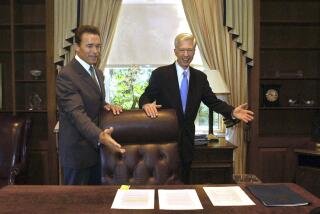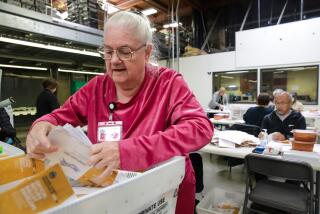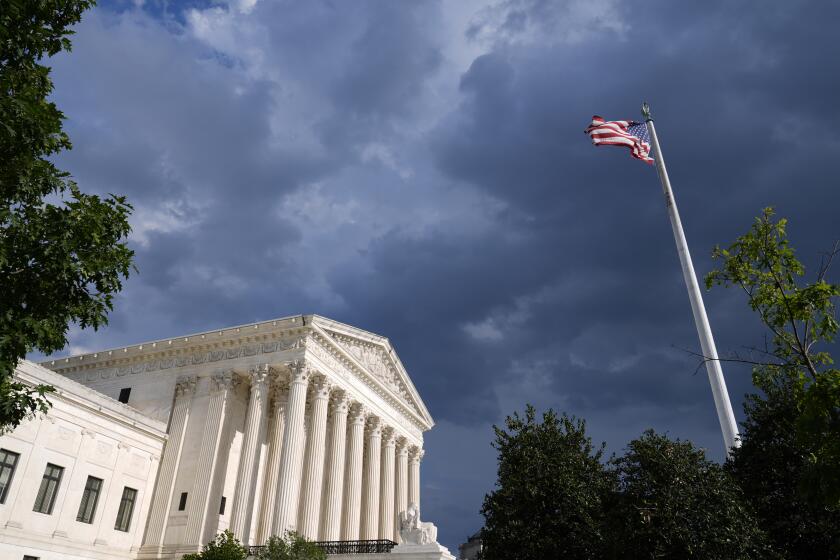It’s Enough to Cause Butterflies
- Share via
In the November 2000 presidential election, George W. Bush beat Al Gore in Florida -- and ultimately gained the presidency -- by 537 votes. More than 170,000 ballots went uncounted in Florida, however, either because no vote for president was recorded (an “undervote”) or because votes were cast for more than one candidate (an “overvote”). There is no doubt that these uncounted ballots -- many of which resulted from poor ballot design and faulty voting equipment -- determined the outcome in Florida and the nation.
Could California’s first-ever gubernatorial recall election likewise be determined by the form of the ballot and the voting machines we use?
Elections experts have long known that in a close contest, these factors can make a difference between winning and losing. And with a ballot that will include about 150 candidates vying to replace Gov. Gray Davis if he is recalled -- with the winner inevitably receiving a relatively small percentage of the total vote -- the design of the ballot is all the more likely to play a critical role in what could be a very close election.
The recall question itself will be fairly simple, an up-down, yes-or-no vote on the question of keeping Davis in office. But how many voters may still be unaware that even if they vote against the recall, they are nevertheless entitled to cast a ballot on the second question of who will replace Davis in the event of a majority vote to recall him?
And consider the ordering of the candidates’ names on the replacement election ballot. Studies have shown that candidates who appear at the top of the ballot may benefit by as much as 5% of the vote in certain types of elections. These studies led the California Supreme Court in 1975 to rule that a randomized, alphabet-based drawing should be used to determine the order of candidates’ names, rather than listing them by party or alphabetical order.
On Monday, California’s secretary of state conducted the lottery for the Oct. 7 recall, with R being the first letter drawn, followed by W, Q, O and so forth. California law also calls for the ballot order to rotate throughout the state’s 80 Assembly districts, so that the candidate listed first in Assembly District 1 moves down to the bottom of the list in Assembly District 2, with everyone else moving up one notch.
California’s system was designed to ensure that each candidate would appear at the top of the ballot an approximately equal number of times. Yet because the number of candidates in the recall far exceeds the number of Assembly districts, some of the candidates on Oct. 7 may never even appear within the top half of the ballot.
Indeed, with so many candidates appearing in absolutely no recognizable order on the recall ballot, some voters may have a difficult time just finding the name of their favored candidate.
But these are not the most problematic issues of ballot design. Elections officials throughout the state are now struggling to figure out how they can physically accommodate the lengthy list of recall candidates on voting equipment that was designed for elections featuring no more than a handful of candidates for each office.
In Palm Beach County’s notorious “butterfly ballot” in 2000, the names of 10 presidential candidates were spread over two facing ballot pages in order to avoid listing them on two successive pages. The confusing ballot design led to the disqualification of 4.2% of the ballots cast in that county as overvotes. Almost overlooked in all the coverage given to the butterfly ballot, however, was the 8.4% overvote rate in Florida’s Duval County, where 21,942 ballots were disqualified because the presidential candidates were in fact listed on two separate pages, leading many voters to erroneously choose a candidate on each page, thereby disqualifying their votes.
In the Oct. 7 recall election, counties like Los Angeles that plan to use the old Votomatic punch-card equipment may be forced to list the replacement candidates on six or seven separate ballot pages. The resulting confusion probably will only be exacerbated by a California law that requires “each group of candidates” on a ballot to be preceded by the instruction “vote for one,” which could lead to the Duval County situation: voters casting ballots for one candidate on each separate page or ballot card they receive.
The best weapon that elections officials have to counteract these problems is voter education. Between now and Oct. 7, these officials will be working overtime to craft instructional materials that try to explain California’s confusing two-part recall ballot to prospective voters.
But the effort cannot stop there. The media should be enlisted to assist in the educational process: Newspapers should start running special boxes to familiarize voters with the recall rules and the form of the ballot to be used in their communities; television stations should make free time available for public service announcements. Counties must also think more creatively in making assistance available on and before election day. Fresno County, for example, is proposing to staff polling places with management-level employees in order to develop a body of well-trained and knowledgeable poll workers.
We can only hope that elections officials and voters have learned from Florida’s debacle and that the recall election in California -- however it turns out -- will be decided not by mistakes caused by a confusing ballot and inadequate voting equipment but on the candidates’ merits.
More to Read
Get the L.A. Times Politics newsletter
Deeply reported insights into legislation, politics and policy from Sacramento, Washington and beyond. In your inbox twice per week.
You may occasionally receive promotional content from the Los Angeles Times.










